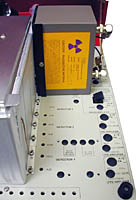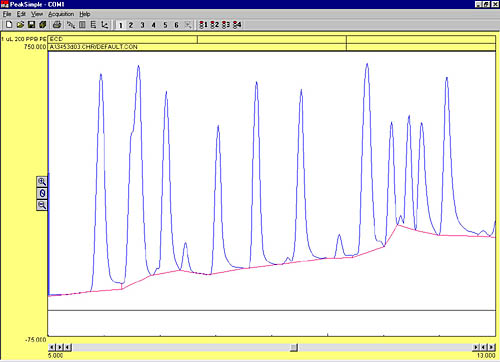|
ECD
- Electron Capture Detector
|
56
|
|
 |
| The SRI Electron Capture Detector can be operated with either nitrogen or argon-5% methane (P5) makeup gas, and nitrogen, P5, or helium carrier (as long as the helium flow is less than 10 milliliters per minute). The ECD may be thermostatted from ambient to 375°C. |
| The ECD detects electronegative compounds, especially chlorinated, fluorinated or brominated molecules such as carbon tetrachloride, bromoform, PCBs and pesticides such as DDT. The ECD offers extreme sensitivity (parts per trillion for SF6). |  |
 |
This chromatogram shows the ECD response to a 200ppb pesticide sample. |
Our ECD consists of a stainless steel cylinder containing radioactive Nickel-63. The Nickel-63 emits beta particles (electrons) which collide with the carrier gas molecules, ionizing them in the process. This forms a stable cloud of free electrons in the ECD cell. When electro-negative compounds enter the cell, they immediately combine with some of the electrons, temporarily reducing the number remaining in the electron cloud. The detector electronics, which maintain a constant current (about 1 nanoampere) through the electron cloud, are forced to pulse at a faster rate to compensate for the decreased number of free electrons. The pulse rate is converted to an analog output, which is connected to the data system.
Because it contains only 5 millicuries of Nickel-63, the ECD is covered by a "general license," which requires a periodic wipe test and the filing of a form with your state's Department of Health or Radiation Safety. In most states, no annual fee is required.
|
8690-0020
|
ECD detector
|
£5,448.00
|
|||